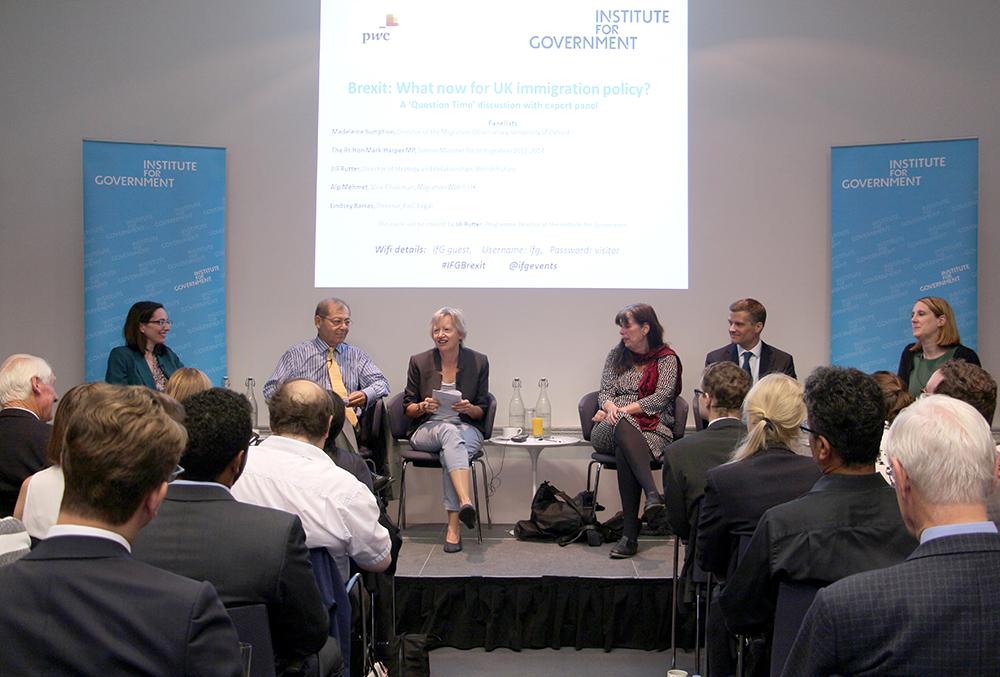Brexit: What now for UK immigration policy?
Our latest Brexit event – held in partnership with PwC – focused on the need to reform the UK immigration system
Our latest Brexit event – held in partnership with PwC – focused on the need to reform the UK immigration system. Robyn Munro finds that there is still no real consensus, even amongst experts.
Most people agree with former immigration minister Mark Harper MP’s assertion that ‘the referendum result was very clear – there’s no chance that free movement as it currently works is going to remain’. What is less clear, however, is what kind of immigration system the UK needs, and the mechanisms government should use to achieve this.
To discuss these issues, we brought together an expert panel, which included Mark Harper; Madeleine Sumption, Director of the Migration Observatory at Oxford University; Alp Mehmet, Vice-Chairman of Migration Watch UK; Jill Rutter, Head of Strategy and Partnerships at British Future; and Lindsey Barras, Director at PwC Legal.
Responsibility for immigration policy falls beyond just the Home Office…
Mark Harper argued that UK immigration policy shouldn’t stop at the Home Office but should involve other parts of Whitehall. Our other panellists agreed: better apprenticeships could help to reduce demand for migrant labour; better use of HMRC tax data could help immigration authorities track the progress of migrants through the labour market, and identify those who are working without permission. Public services as a whole, Harper argued, must learn from the private sector about how to respond to changes in demand; in areas of high immigration, you don’t hear complaints about queues at Tesco, but you do hear about queues at GP surgeries.
… and government should go beyond Whitehall, engaging business and the public
Lindsey Barras suggested that government needed to engage business on two levels. The first is to understand why it’s important that businesses can employ migrant workers, but also to challenge employers to look at how they can hire more UK workers. Many companies employ workers from the EU not just for their skills set, but to create a more diverse workforce to match their client base. The current system can be cumbersome: small start-ups looking to sponsor a single EU worker and large corporations like PwC with hundreds of EU employees must go through the same onerous process. The referendum result is an opportunity, she argued, to develop a system that meets the needs of businesses, while also encouraging them to employ more UK workers. She concluded that while the UK Government has been good at consulting the private sector on immigration policy, this dialogue must continue.
Jill Rutter added that consultation needed to go beyond businesses to include the public as a whole. She noted that the Canadian Government has just launched a national conversation about immigration policy, including surveys, polling and citizen juries. Alp Mehmet countered that while it is government’s job to consult, we had just had a three-month national consultation – the EU referendum campaign had made clear that ‘we do need to get migration down’.
So what will the new immigration system look like?
There were a few points of agreement on the future system:
- Immigration must remain a UK-wide system: any attempt to direct migrants to certain areas, or set up different rules for different parts of the country, would be impossible to control without setting up internal land borders.
- There should be no ‘blanket rights’ for EU citizens currently living in the UK: while the panel expected that EU citizens currently living in the UK would be allowed to stay, granting a universal right to remain would leave us unable to deport EU citizens – such as prisoners – with no right to stay in the UK.
- The Ireland-Northern Ireland land border won’t pose a problem: while some have raised concerns that a land border with the EU will make it harder to enforce immigration controls, Mark Harper pointed out that the immigration system isn’t aimed at controlling the flow of people coming in to the country, but preventing them from working or settling permanently without permission.
But beyond these areas of agreement, our panel didn’t agree on what a future immigration system should look like after the UK leaves the EU.
Madeleine Sumption suggested that a work permit-based system was most likely, but that the Government would need to strike a balance between creating a ‘one size fits all’ system, and one which responded to the different needs of different sectors but was unwieldy and bureaucratic. She also cautioned against combining a criteria-based system with an overall cap on migration, as a different numbers of applicants would meet criteria each year.
Mark Harper suggested that a future system could apply different rules not only to different sectors but also to different EU countries, perhaps continuing to allow low-skilled workers from Poland but limiting those from other parts of the EU.
The panel agreed that the implementation challenges of any system also had to be taken into account. Jill Rutter suggested that the current cost of border control – around £28 per head – would need to rise to cope with EU as well as non-EU immigration. Lindsey Barras warned that the Government’s current practice of policing immigration at the border might have to be changed to pre-qualification or managing migrants once they are in the country, to prevent huge queues at airports.
It is clear that there are many options for the future UK system, and many voices to be heard. The Government must find a way of reconciling these often conflicting interests, and developing a system that fulfils public demand for more control over immigration.
- Topic
- Brexit
- Keywords
- Immigration Withdrawal Agreement
- Political party
- Conservative
- Administration
- May government
- Publisher
- Institute for Government
